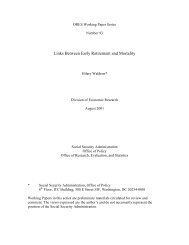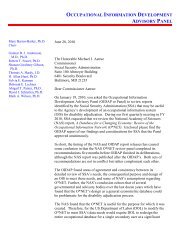Download entire publication - Social Security
Download entire publication - Social Security
Download entire publication - Social Security
Create successful ePaper yourself
Turn your PDF publications into a flip-book with our unique Google optimized e-Paper software.
Table 6.Estimated occupational distributions of the employed population with work disabilities, by occupationalchoicemodel aOccupationSSI recipientsNon-SSI recipients with—No disability Any disability Work disabilityTotal 100.00 100.00 100.00 100.00Management, professional, and related 20.10 28.56 23.48 23.48Management 3.60 8.93 5.86 5.86Business and financial operations 2.49 3.67 3.03 3.03Computer and mathematical, architecture andengineering, life, physical and social science 1.01 3.85 2.93 2.93Community and social services 1.33 1.25 1.56 1.56Legal 0.54 0.85 0.67 0.67Education, training, and library 4.25 4.11 3.78 3.78Arts, design, entertainment, sports, and media 3.96 1.53 1.53 1.53Health-care practitioner and technical 2.93 4.37 4.12 4.12Service 30.05 17.39 22.76 22.76Health-care support 2.39 2.49 3.22 3.22Protective service 1.75 2.08 2.26 2.26Food preparation and serving related 5.53 4.97 6.20 6.20Building and grounds cleaning and maintenance 10.67 4.46 6.49 6.49Personal care and service 9.72 3.38 4.60 4.60Sales and office 23.07 26.47 24.44 24.47Sales and related 7.92 10.84 10.65 10.65Office and administrative support 15.15 15.63 13.79 13.79Farming, fishing, and forestry 0.49 0.67 0.75 0.75Construction, extraction, maintenance, and repair 5.21 11.33 11.22 11.22Production, transportation, and material moving 21.07 15.58 17.36 17.36Production 8.29 8.23 8.33 8.33Transportation and material moving 12.77 7.35 9.03 9.03SOURCE: Author's calculations using the 2007 American Community Survey.NOTES: The sum of individual categories may not equal the total because of rounding.a. The occupational-choice models are based on separate multinomial logit regressions of occupation for each population group.Covariates in all models include sex, ethnicity, race, marital status, education, age, and age squared. The disabled, work-disabled, andworking-SSI models also include disability type as additional covariates. All estimates use ACS balanced repeated replicate sampleweights. See Table A-3 for the results of the models.There is an increase in the percent of these populationsin service occupations under the working-SSImodel—21 percent to 28 percent for those with adisability (Table 4), 16 percent to 25 percent forthose without a disability (Table 5), and 23 percent to30 percent for those with a work disability (Table 6).This is largely due to increases in the percentageworking in building and grounds cleaning and maintenanceoccupations. Construction, extraction, maintenance,and repair occupations also see large declines,as would be expected given the results in Table 3.The concentration of predicted occupations somewhatfollows that of the actual occupations (Table 7,panel A). The working SSI recipient occupationalchoicemodel yields the highest concentration ofoccupations for all groups. Additionally, under eachmodel, working SSI recipients have the highest HHI,reflecting more concentrated distributions. Theoccupational concentrations are not lowest under theno-disability occupational-choice model, as might beexpected, although people without disabilities have thelowest concentrations under each model, other thanthe working SSI recipient model. However, all threenonrecipient models yield similar HHI values.Controlling for demographic characteristics, humancapital, and disability type greatly reduces the dissimilaritybetween the distributions of the variousgroups (Table 7, panel B). Compared with Table 2, the58 <strong>Social</strong> <strong>Security</strong> Bulletin • Vol. 69 • No. 3 • 2009








